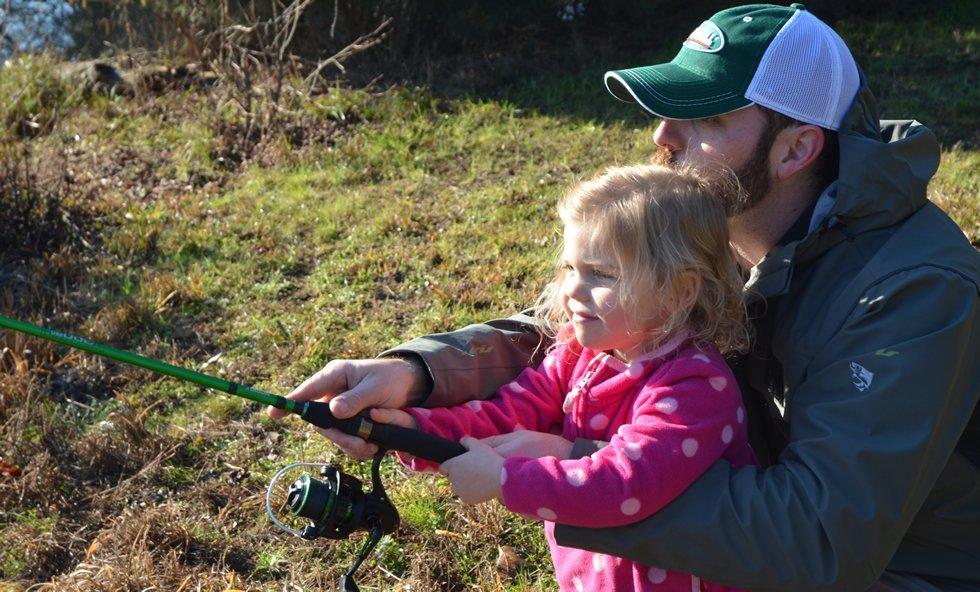Introducing Kids to Fishing
One of the greatest facets of fishing is its non-discriminatory nature. Quite simply, the fish don't care if you're tall or short, big or small, old or young. If a bait is presented properly, a fish will bite no matter who is holding the other end of the line. Toddlers as young as two can begin fishing with the assistance and guidance of their parents or grandparents. While many adults are eager to teach their youngsters, there is a right way, and a wrong way, to introduce a child to fishing.
Start Early, But Slowly
One of the biggest mistakes you can make is to rush a child into fishing with overexposure. If you think a preschooler can sit in a boat and fish for hours like your best buddy, you're in for a rude awakening. Training a future fisherman or fisherwoman is a process that takes time. Start that process by simply taking a nature walk to a local lake or river. Strolling along the shoreline and spotting a fish or two will peak their curiosity.
When it's time to actually fish, plan a short trip of an hour or less. Go when the weather is ideal and you have a place in mind where the child is certain to catch fish. Six-pound largemouths or 10-pound catfish are not necessary. The important thing is that the kids are getting frequent bites to hold their attention. Typically, bluegills are your best bet as they live near the shoreline and are eager to bite. Before the child begins to lose interest, call it a day. That way they are left wanting more. At home, continue the process by reading children's fishing books and showing them your tackle box. It's also a good idea to practice casting and reeling in the basement or out in the backyard. Again, keep it brief – even the practice sessions.
Bring Snacks, Take Breaks
After a few outings, slowly increase the length of future trips. Try fishing in periods. Fish for 30 minutes and then take a break. Fish for 30 minutes and then take another break. Snacks and snack breaks can do wonders for young anglers. Granola bars, crackers, nuts, and cheese sticks all fit the bill. Keep these snacks out of the sun, ideally in a cooler, and avoid chocolate as it causes melty messes. In addition to food, water and juice boxes help revive a child's energy level and can elongate a trip.
In between bites, foster the child's observation skills. If your boat has a livewell, allow them to poke their head in and watch the fish swim. Let them touch the bait, both live and artificial. Let them listen to the sounds of nature and smell everything – both good and bad. While live worms work great, a Berkley ® Gulp! Alive!® Fish Fry rigged under a small bobber is the ideal setup. The bobber gives the kids a visual representation and the Fish Fry is more durable than live bait. Plus, the strong scent from the Berkley ® Gulp! not only appeals to fish, but also to children's senses. During these breaks, begin teaching concepts of conservation and how our lakes and rivers are ecosystems that many plants and animals use.
Patience, patience, patience
With young children, it's inevitable that things will go awry. Snags, tangles, and backlashes are all part of the process. Instead of showing frustration, teach your child that mistakes are OK and are a part of learning.
Adults need to bite the bullet and accept that they won't be doing much fishing. Instead, they'll be baiting hooks, taking off fish, and tending to the inevitable issues. Any adult catches should be considered a bonus. If you do hook into a good one, consider letting your child reel it in. If they decline, encourage them to net the fish. That way, the child takes ownership of the catch as teamwork was used.
If a fish comes unbuttoned, don't place blame on the child. Instead, calmly explain what happened. Celebrate fish catches with hugs and high fives and take plenty of pictures to capture the moment. Have your child be the storyteller and share the photos with family and friends.
Essential Equipment
Children, just like adults, need equipment that is built for their needs. A 5-year-old, or even an 8-year-old, cannot handle adult-sized rods and reels comfortably. Shorter rods and smaller, lighter reels will reduce fatigue and overall frustration. Mitchell manufactures a number of 5 1/2-foot combos that are perfect for kids ages 7 and up, in particular, the Mitchell® Avocet® R Combo.
For children under 12, and in some states 16, fishing licenses are not needed, but be sure to check your local regulations as rules differ based on species and resident status. Lifejackets are also an essential piece of equipment, and are required by law for most boaters under 16. Model safe angling behavior by wearing one yourself. The child's life jacket, much like the rod and reel, should fit – not only for safety but also for comfort. A lifejacket that is too big or too small will hinder a child's natural casting motion. Choose one that looks cool, fits snuggly, and doesn't restrict movement.
While every child is different, following these guidelines should increase your chances of hooking a lifelong fishing partner.

